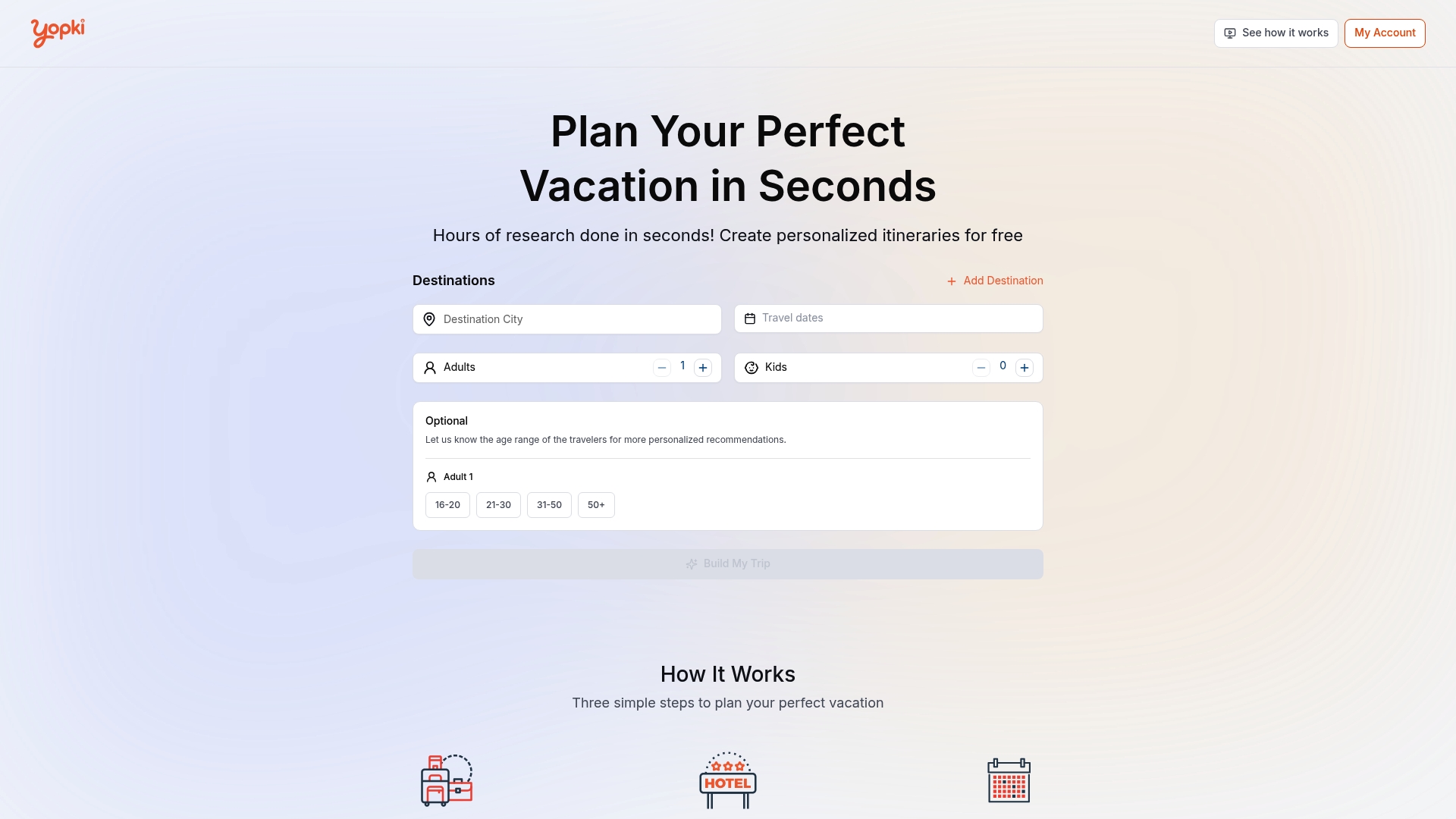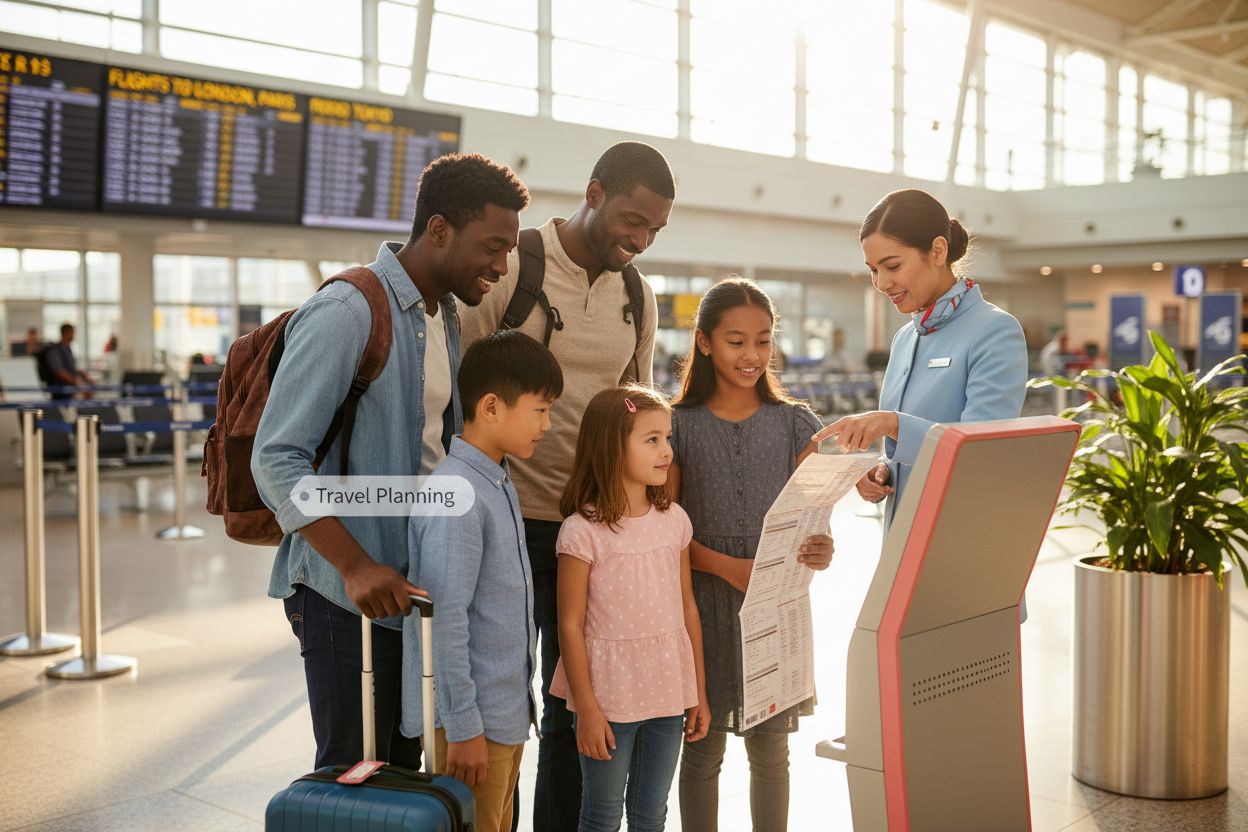Trip planning has exploded with digital tools that promise to make travel smooth and stress-free. But get this. Over 80 percent of travelers now rely on online platforms to organize their journeys, yet most people feel overwhelmed by too many choices and confusing features. The real secret to better trips is not having dozens of apps, but knowing exactly which smart tools fit your style—and how a few clicks can erase hours of chaos.
Table of Contents
- Understanding The Importance Of Trip Planning Tools
- Key Features To Look For In A Trip Planning Tool
- Top User-Friendly Trip Planning Tools Available
- Comparing Free Vs. Paid Trip Planning Tools
- Tips For Integrating Your Travel Plans With Apps
- How To Use Trip Planning Tools For Family Travel
- Best Trip Planning Tool For Solo Travelers
Quick Summary
| Takeaway | Explanation |
|---|---|
| Use planning tools for stress reduction | Digital trip planning tools simplify logistics and enhance your travel experience by reducing stress and improving organization. |
| Select tools with comprehensive features | Look for platforms that offer real-time collaboration, dynamic mapping, and budgeting tools for effective travel preparation. |
| Prioritize user-friendly apps | Choose tools with intuitive designs that require minimal learning to ensure effortless planning and navigation. |
| Customize itineraries for family travel | Use collaborative features to create shared itineraries that accommodate diverse interests and budgets of family members. |
| Consider safety features for solo travelers | Opt for apps that provide safety tracking and emergency contact integration to enhance security during independent travel. |
1: Understanding the Importance of Trip Planning Tools
Travel planning has transformed from complicated paper maps and guidebooks to sophisticated digital solutions that simplify every aspect of your journey. Modern travelers need efficient tools that streamline research, booking, and organization to create seamless travel experiences. Understanding the role of trip visualization becomes crucial in navigating the complexities of contemporary travel.
Trip planning tools have become essential for travelers seeking to optimize their experiences and reduce stress. According to research from the Journal of Travel & Tourism Marketing, digital planning platforms significantly impact how individuals approach travel preparation across different age groups.
The core benefits of using advanced trip planning tools include:
-
Comprehensive Destination Research: Access curated information about locations, attractions, and travel requirements
-
Time and Cost Optimization: Compare prices, find best routes, and minimize unnecessary expenses
-
Personalized Itinerary Creation: Generate custom travel plans tailored to individual preferences and constraints
Moreover, these tools help travelers mitigate potential challenges by providing real-time information, collaborative planning features, and intelligent recommendation systems. By leveraging technology, individuals can transform complex travel logistics into manageable, enjoyable experiences that maximize adventure while minimizing uncertainty.
Whether you are a solo traveler, family vacationer, or business professional, understanding and utilizing the right trip planning tools can dramatically enhance your travel preparedness and overall journey satisfaction.
2: Key Features to Look for in a Trip Planning Tool
Selecting the right trip planning tool requires understanding the critical features that transform travel preparation from stressful to seamless. Tips for finding the best travel planner can help travelers navigate the complex landscape of digital planning solutions.
According to research from the U.S. Department of Transportation, effective trip planning tools should offer comprehensive functionality that goes beyond basic route mapping. The most powerful platforms provide integrated solutions that address multiple aspects of travel preparation.
Key features travelers should prioritize include:
-
Real-Time Collaboration: Ability to share and edit itineraries with fellow travelers
-
Dynamic Routing and Mapping: Interactive maps with intelligent route suggestions
-
Budget Tracking: Comprehensive financial management tools for expense monitoring
-
Comprehensive Travel Documentation: Centralized storage for tickets, reservations, and essential travel documents
Beyond these fundamental features, advanced trip planning tools distinguish themselves through intelligent personalization. These platforms utilize machine learning algorithms to recommend attractions, restaurants, and activities tailored to individual traveler preferences, past experiences, and specific trip parameters.
Additionally, top-tier trip planning tools integrate multiple functionalities. They combine destination research, booking capabilities, expense tracking, collaborative planning, and personalized recommendations into a single, user-friendly platform. By offering such comprehensive solutions, these tools eliminate the need for travelers to juggle multiple applications and spreadsheets.
The ultimate goal of any exceptional trip planning tool is to reduce travel-related stress while maximizing enjoyment and efficiency. Travelers should seek platforms that not only organize logistical details but also inspire and enhance the overall travel experience.
3: Top User-Friendly Trip Planning Tools Available
The digital landscape of trip planning tools has evolved dramatically, offering travelers sophisticated yet intuitive platforms that simplify travel preparation. Best trip planning apps for US travelers demonstrate the incredible technological advancements transforming how we approach travel logistics.
According to research from the University of California, Berkeley’s School of Information, modern trip planning tools leverage artificial intelligence and machine learning to provide personalized travel experiences.
When evaluating user-friendly trip planning tools, travelers should consider platforms that offer:
-
Seamless User Interface: Intuitive design with minimal learning curve
-
Comprehensive Feature Set: Integrated booking, itinerary management, and travel recommendations
-
Cross-Platform Compatibility: Accessible via web and mobile applications
Google Trips stands out for its integration with existing Google services, allowing users to sync travel information directly from Gmail and Google Calendar. The platform provides automatic itinerary creation, local recommendations, and offline access to critical travel documents.
TripIt offers a robust solution for travelers seeking comprehensive organizational tools. Its strength lies in automatic itinerary compilation by forwarding confirmation emails, providing a centralized hub for all travel-related information.
For budget-conscious travelers, Roadtrippers specializes in creating detailed route plans with cost-effective suggestions. The platform excels at helping users discover unique attractions and optimize travel expenses along their chosen routes.
Embracing these advanced trip planning tools transforms travel preparation from a complex task into an enjoyable, streamlined experience. By selecting platforms that combine technological sophistication with user-friendly design, travelers can focus more on anticipating their adventures and less on logistical challenges.
4: Comparing Free vs. Paid Trip Planning Tools
Navigating the landscape of trip planning tools requires understanding the fundamental differences between free and paid platforms. Best apps for itinerary planning can help travelers make informed decisions about which type of tool best suits their specific travel needs.
According to research examining travel planning applications, the distinctions between free and paid tools extend far beyond simple pricing structures.
Key differences between free and paid trip planning tools include:
-
Feature Complexity: Free tools offer basic functionalities, while paid platforms provide advanced features
-
Customization Levels: Limited personalization in free versions versus extensive customization in premium tools
-
Data Security: Typically stronger encryption and privacy protections in paid platforms
Free Trip Planning Tools are ideal for casual travelers or those planning occasional trips. Platforms like Google Trips and TripAdvisor offer basic itinerary tracking, general destination information, and rudimentary planning capabilities without financial commitment.
Paid Trip Planning Tools cater to frequent travelers, business professionals, and those seeking comprehensive travel management. These platforms provide advanced features such as:
- Detailed expense tracking
- Real-time flight and hotel updates
- Personalized recommendations based on travel history
- Comprehensive travel insurance integration
While free tools can suffice for simple trips, paid platforms offer a more robust, tailored experience. The additional investment translates to time savings, enhanced travel insights, and a more streamlined planning process.
Ultimately, the choice between free and paid trip planning tools depends on individual travel frequency, complexity of trips, and personal budget considerations. Travelers should carefully evaluate their specific needs before selecting a platform that aligns with their travel planning requirements.
5: Tips for Integrating Your Travel Plans with Apps
Successful travel planning requires seamless digital integration that transforms complex logistics into manageable experiences. Essential tips for using a travel itinerary app can help travelers maximize the potential of their digital planning tools.
According to research from the National Institutes of Health, effective app integration involves strategic approaches to data synchronization and privacy management.
Critical steps for integrating travel plans with apps include:
-
Centralize Your Information: Select a primary app that can aggregate multiple travel documents
-
Enable Cloud Synchronization: Ensure automatic updates across devices
-
Manage App Permissions: Control data sharing and privacy settings carefully
Syncing Calendars and Emails
Modern travel apps offer powerful integration capabilities. Most platforms can automatically import travel confirmations from email accounts, creating instant itineraries without manual data entry. Users should leverage email forwarding features and grant necessary permissions to streamline this process.
Cross-Platform Compatibility
Travelers should prioritize apps that offer:
-
Compatibility with multiple devices
-
Offline access capabilities
-
Seamless integration with existing digital ecosystems
Security Considerations
Two-factor authentication and encrypted data storage are essential when connecting travel apps across different platforms. Travelers must carefully review privacy policies and understand how their personal information will be managed and protected.
By adopting a strategic approach to app integration, travelers can transform their digital planning tools from simple booking platforms into comprehensive travel management systems. The key is selecting interconnected applications that communicate effectively while maintaining robust security protocols.
6: How to Use Trip Planning Tools for Family Travel
Family travel demands sophisticated planning strategies that accommodate diverse age groups, interests, and logistical challenges. Best trip planning apps for US travelers can transform complex family vacation preparation into an enjoyable, collaborative experience.
According to research from Senior Planet, leveraging digital tools can significantly simplify family travel planning by providing customized recommendations and comprehensive organization.
Essential considerations for family trip planning include:
-
Collaborative Features: Tools that allow multiple family members to contribute and edit itineraries
-
Age-Appropriate Activity Filtering: Platforms offering recommendations suitable for different family member ages
-
Budget Tracking: Comprehensive expense management across shared family trips
Engaging Family Members in Planning
Modern trip planning tools enable interactive family planning experiences. Parents can create shared digital spaces where children contribute destination ideas, helping build excitement and investment in the upcoming trip. Some advanced platforms offer gamification elements that make trip planning engaging for younger travelers.
Digital Safety and Tracking
Advanced family travel apps provide additional safety features such as:
-
Real-time location sharing
-
Emergency contact integration
-
Medical information storage
Personalization and Flexibility
Customizable itineraries are crucial for family travel. The best planning tools offer drag-and-drop interfaces, allowing families to adjust schedules, swap activities, and accommodate unexpected changes without complete plan reconstruction.
By embracing technology-driven planning approaches, families can transform travel preparation from a potential source of stress into an enjoyable, collaborative journey. The key is selecting platforms that balance comprehensive features with user-friendly interfaces, ensuring every family member feels included and excited about the upcoming adventure.
7: Best Trip Planning Tool for Solo Travelers
Solo travelers require specialized digital tools that offer flexibility, safety, and comprehensive planning capabilities. Best trip planner apps for effortless travel planning can transform independent travel experiences into seamless, well-organized adventures.
According to research from the National Institutes of Health, digital travel planning tools significantly reduce travel-related stress and enhance self-efficacy for independent travelers.
Key features solo travelers should prioritize include:
-
Safety Tracking: Real-time location sharing and emergency contact integration
-
Budget Management: Comprehensive expense tracking and cost prediction tools
-
Flexible Itinerary Design: Easy modification of travel plans without penalties
Personal Safety and Connectivity
Ideal solo travel planning tools provide robust safety features such as offline map downloads, local emergency service connections, and secure communication channels. These platforms help solo travelers maintain connectivity and personal security while exploring unfamiliar destinations.
Personalization and Recommendations
Advanced solo travel apps offer:
-
Customized activity suggestions based on personal interests
-
Accommodation recommendations tailored to solo traveler preferences
-
Language translation and cultural insight features
Cost-Effective Planning
Budget optimization becomes crucial for solo travelers. The most effective tools provide dynamic pricing alerts, compare multiple travel options, and help users make financially intelligent decisions without compromising travel experiences.
By selecting comprehensive, user-friendly digital platforms, solo travelers can transform their journey planning from a potential source of anxiety into an exciting, empowering process. The right trip planning tool becomes more than just a technological aid it becomes a trusted travel companion.
Below is a comprehensive table summarizing the critical aspects, key features, and actionable insights from the entire article on the best trip planning tools for effortless travel.
| Core Topic | Key Points/Outcomes | Benefits for Travelers |
|---|---|---|
| Importance of Trip Planning Tools | Streamline research, bookings, and organization; reduce chaos with curated and automated features. | Save time, minimize stress, improve preparedness |
| Essential Features to Look For | Real-time collaboration, dynamic routing, integrated budgets, document storage, AI-driven personalization | Enhanced efficiency, tailored recommendations |
| Top User-Friendly Tools | Google Trips, TripIt, Roadtrippers—emphasize ease of use, automation, and compatibility | Simple learning curve, centralized plans |
| Free vs. Paid Tools | Free: basic planning tools; Paid: advanced customization, data security, live updates, comprehensive extras | Match tools to your needs and trip complexity |
| Integrating Travel Apps | Sync documents, use cloud updates, manage permissions and privacy, ensure cross-device access | Consolidate plans, improve access and data safety |
| Family Trip Planning | Collaborative features, age filtering, shared budgets, safety tracking, engaging for all ages | Custom plans all members enjoy, safer travel |
| Solo Traveler Tools | Safety tracking, flexible itineraries, cost control, offline access, tailored suggestions | Independence, confidence, and peace of mind |
Effortless Trip Planning Starts Here
Planning a trip should spark excitement, not frustration. The article highlights how jumping between multiple apps, spreadsheets, and endless online searches can complicate your journey before it even begins. You deserve a smarter way to create a fully personalized itinerary, keep every ticket in one place, and visualize your trip without stress. The right tool empowers you to save time, reduce travel anxiety, and focus on real adventure.

Ready to leave the chaos of scattered plans behind? Discover how Yopki’s all-in-one travel platform transforms stressful planning into a seamless experience. Let our intelligent itinerary builder, smart calendar, and built-in AI Travel Concierge help you create your perfect trip. Visit https://yopki.com right now and start turning your travel dreams into reality.
Frequently Asked Questions
What are trip planning tools and why are they important?
Trip planning tools are digital applications designed to simplify travel preparation by offering features such as itinerary creation, expense tracking, and destination research. They help travelers optimize their experiences and reduce stress during the planning process.
What features should I look for in a trip planning tool?
Key features to look for include real-time collaboration, dynamic routing and mapping, budget tracking, comprehensive travel documentation, and intelligent personalization to tailor recommendations based on your preferences.
Are free trip planning tools worth using?
Free trip planning tools are beneficial for casual travelers or those planning occasional trips, but they may lack advanced features and customization options. For frequent travelers or complex trips, paid tools usually offer more robust solutions.
How can I integrate my travel plans with different apps?
To integrate travel plans effectively, choose a primary app that centralizes your information, enable cloud synchronization for automatic updates, and ensure your app permissions are managed for data privacy. Most travel apps can import confirmations directly from email, simplifying itinerary creation.



